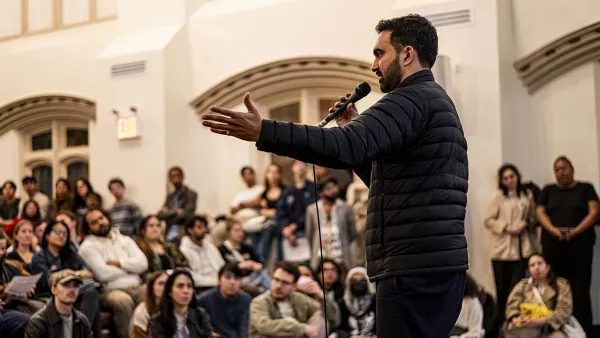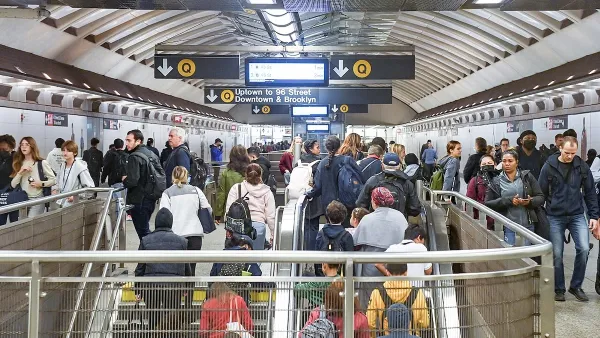Those of us who cherish cities have much to be grateful for (at least in some cities).

This weekend marks the beginning of the Jewish holiday of Passover, which in turn begins with a festive meal called The Seder. One of my favorite parts of the Seder is the song "Dayenu." The term "Dayenu" means "it would have been enough" or "it would have sufficed." In this song, participants sing or chant: "If God had done A but not B for us, it would have sufficed; if God had done B but not C for us, it would have sufficed" and so on. It seems to me that the song is designed to review the story of the Exodus from Egypt and related events, while instilling a sense of gratitude in listeners.
It seems to me that this song/poem could be adapted to urbanism—at least in relatively successful cities such as New York. One might start off by saying:
"If New York had the magnificent building stock of the 1920s, but had not added parks and playgrounds, it would have been enough.
If the city had added parks and playgrounds in the 1930s, but Robert Moses's plans to run expressways through the city had not been stopped, it would have been enough.
If Jane Jacobs had stopped Moses's plans to run expressways through the city in the 1960s, it would have been enough." But of course, the city suffered quite a bit from sprawl and poverty and crime in the 1960s and the 1970s. So I am a bit more grateful for the reforms of the 1970s and 1980s. So I might add:
"If the city had been financially stabilized in the 1970s but not saved the subway, it would have been enough;
If the city had had the subway retrofitted, it would have been enough."
Financial stability and a functional subway in turn made the city more desirable to immigrants (both from the rest of the world and to the rest of the United States). But even though the city was growing again in the 1980s, one thing was missing: safety. Under Mayors Giuliani and Bloomberg, this problem was solved. When Giuliani took office in 1993, New York was more dangerous than many cities (though, contrary to popular conventional wisdom, some cities were more dangerous even then). Today, it is, I think, the safest large city in the United States.*
So I would add: "If the city had become safe, it would have been enough."
Once crime was under control, the city began to tackle quality of life issues such as transportation. Under Mayor Bloomberg, the city began to add bike lanes and pedestrian plazas to make more of the city's streets desirable places to walk and bike.
So I would add: "If the city had added bike lanes but not pedestrian plazas, it would have been enough; If the city had added pedestrian plazas, it would have been enough."
But just as the ancient Hebrews and their modern descendants have suffered all kinds of post-liberation setbacks and problems, New York and other prosperous cities still have significant problems. The city’s popularity means higher demand for housing and higher rents, homelessness is rampant, and the subway needs a new round of retrofitting. I hope that in a few decades, other writers will be able to add additional lines of Dayenu to this blog post- and I also hope that you can add a few lines of Dayenu for your own city!
*For city crime rates go to city-data.com. The only major cities with lower crime rates are cities like San Jose that annexed huge amounts of suburbia. But among cities trapped within their 1950 boundaries, I am pretty sure New York stands alone.

Planetizen Federal Action Tracker
A weekly monitor of how Trump’s orders and actions are impacting planners and planning in America.

Maui's Vacation Rental Debate Turns Ugly
Verbal attacks, misinformation campaigns and fistfights plague a high-stakes debate to convert thousands of vacation rentals into long-term housing.

San Francisco Suspends Traffic Calming Amidst Record Deaths
Citing “a challenging fiscal landscape,” the city will cease the program on the heels of 42 traffic deaths, including 24 pedestrians.

Amtrak Rolls Out New Orleans to Alabama “Mardi Gras” Train
The new service will operate morning and evening departures between Mobile and New Orleans.

The Subversive Car-Free Guide to Trump's Great American Road Trip
Car-free ways to access Chicagoland’s best tourist attractions.

San Antonio and Austin are Fusing Into one Massive Megaregion
The region spanning the two central Texas cities is growing fast, posing challenges for local infrastructure and water supplies.
Urban Design for Planners 1: Software Tools
This six-course series explores essential urban design concepts using open source software and equips planners with the tools they need to participate fully in the urban design process.
Planning for Universal Design
Learn the tools for implementing Universal Design in planning regulations.
Heyer Gruel & Associates PA
JM Goldson LLC
Custer County Colorado
City of Camden Redevelopment Agency
City of Astoria
Transportation Research & Education Center (TREC) at Portland State University
Jefferson Parish Government
Camden Redevelopment Agency
City of Claremont






























